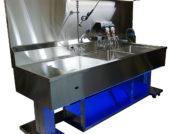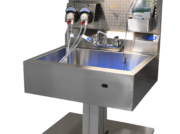
Unlocking Solutions: The Power of Customization for Problem Solving
Customization is defined as “the action of modifying something to suit a particular individual or task.” In sterile processing and GI / gastroenterology departments, there is no shortage of unique tasks that need to be accomplished each day. Between varying sizes, layouts, capabilities, and instruments, there’s a tremendous amount of opportunity to solve problems through customization.
Let’s explore some of the ways departments have leaned on custom solutions to solve their unique problems and achieve their goals.
The Challenge: Consolidating Wrapping During Assembly
The Custom Solution: Hybrid Ergonomic WorkStations
Many sterile processing departments are re-organizing their percentage of rigid containers versus wrapped trays. Adjusting this ratio can have impacts to an assembly department’s layout, workflow, and equipment needs.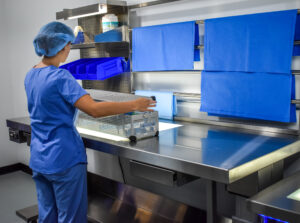
For one facility in Colorado, this was exactly the case. As rigid container use climbed and wrapping decreased, the need to consolidate wrapping & blue wrap storage became a priority. Only one technician was required for wrapping during a shift. All other prep and pack tables were designed for rigid containers and peel packs only.
The other need? Integrated tracking software and visual inspection technology for IFU compliance at the same wrapping station. The table that did both those things? Nonexistent.
Enter the Hybrid Ergonomic Workstation. By integrating rungs to hang and store blue wrap, and a pegboard to integrate tracking systems and task lights, the team found the best of both worlds. A blue wrap rack was replaced with a functional station, additional electrical was integrated, a built-in light inspected wrap before use, and time spent gathering materials was reduced dramatically with a single station.
The Challenge: Three Basins and Staging Space for an Endoscope Reprocessing Sink
The Custom Solution: Staging Panels
When a GI / endoscopy department was pressed for space but looking for a three-basin sink option that could accommodate their endoscopes, they decided that a sink with turned basins would be the best way to achieve their goals. With three full sink basins on a 78” sink, staging space became a challenge.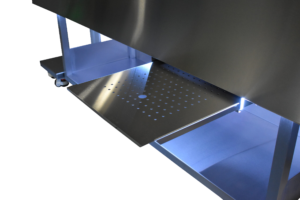
To afford more counterspace within the limited area the sink occupied, stainless steel staging panels were added, along with an integrated housing for the panels below the skirt of the sink. This allowed a sink basin to be converted into counterspace when needed, while ensuring the staging panel was out of the way when all sink basins were in use.
The Challenge: Separating Clean and Dirty Solutions
The Custom Solution: In-basin solution tank
One facility, planning for a new endoscope reprocessing department, had an opportunity to enhance their processes and practices to better align with the (then) new ANSI/AAMI ST91: 2021 standards.
The department was putting particular emphasis on reducing any potential recontamination, even during the cleaning process. This would comply with the recommendation found in ANSI/AAMI ST91: 2021: 7.6-J “a fresh cleaning solution should be used” when addressing the use of automated flushing during the manual cleaning process.
The goal: flush fresh cleaning solution and rinse water through the endoscope without drawing from the sink where the scope was submerged. Prior to this project, the facility was using disposable basins that posed a splash risk and required some workarounds within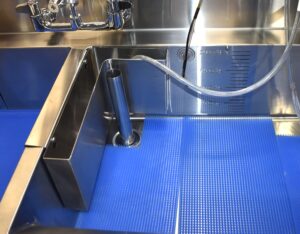 their set up to ensure compliance.
their set up to ensure compliance.
Cue: An in-basin reservoir! This customized reservoir allowed for reprocessing techs to fulfill the recommendation in AAMI ST91 without twisting, bending, maneuvering, or balancing to fill and use the reservoir to flush fresh cleaning solutions and final rinse water through the endoscope channels. Ergonomically, it reduced twist and pinch points for the staff. Functionally, it kept the manual cleaning process confined to the appropriate basin.
And it didn’t stop there! The same concept was applied to their rinse sink, achieving the same goals.
The Challenge: Accessibility for Sinks in Tight Installs
The Custom Solution: Hinged Pegboard
GI departments have many uses for pegboards. Just like their sterile processing counterparts, having tools and materials within arms reach is not only convenient, but it also streamlines workflows and promotes optimal ergonomics. One notable challenge faced in GI regarding pegboards, however, was an inability to clean behind them.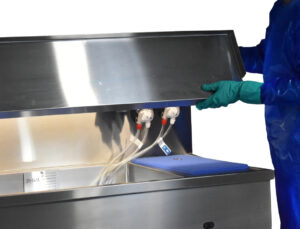
In many instances, sinks are placed in tight spaces, making it difficult to access the space behind them. Further, if sinks are hard-plumbed, moving them from their position requires a notable amount of effort to make happen. Enter: the hinged pegboard.
Hinged pegboards deliver the organizational and ergonomic benefits of standard pegboards, with the added capability to simply fold the pegboard forward to access the area behind it for cleaning. Another benefit derived from this design is the ability to change the accessories and equipment attached to the pegboard more easily. This allows departments to evolve the capabilities of the sink as the department’s needs change.
Conclusion
Reprocessing departments come across unique challenges while trying to achieve the same goals: adhere to standards, guidelines and IFUs, and keep patients safe. However, no two departments are the same, and it can be difficult to solve problems with “standard” equipment designed for facilities that may not resemble theirs.
Customization offers departments the ability to make their equipment work in the space they have available and meet their unique needs. SPD & GI departments come in all shapes and sizes. With customization, their equipment can, too.
Looking to solve some unique problems in your department? Let’s design your custom solution together!




